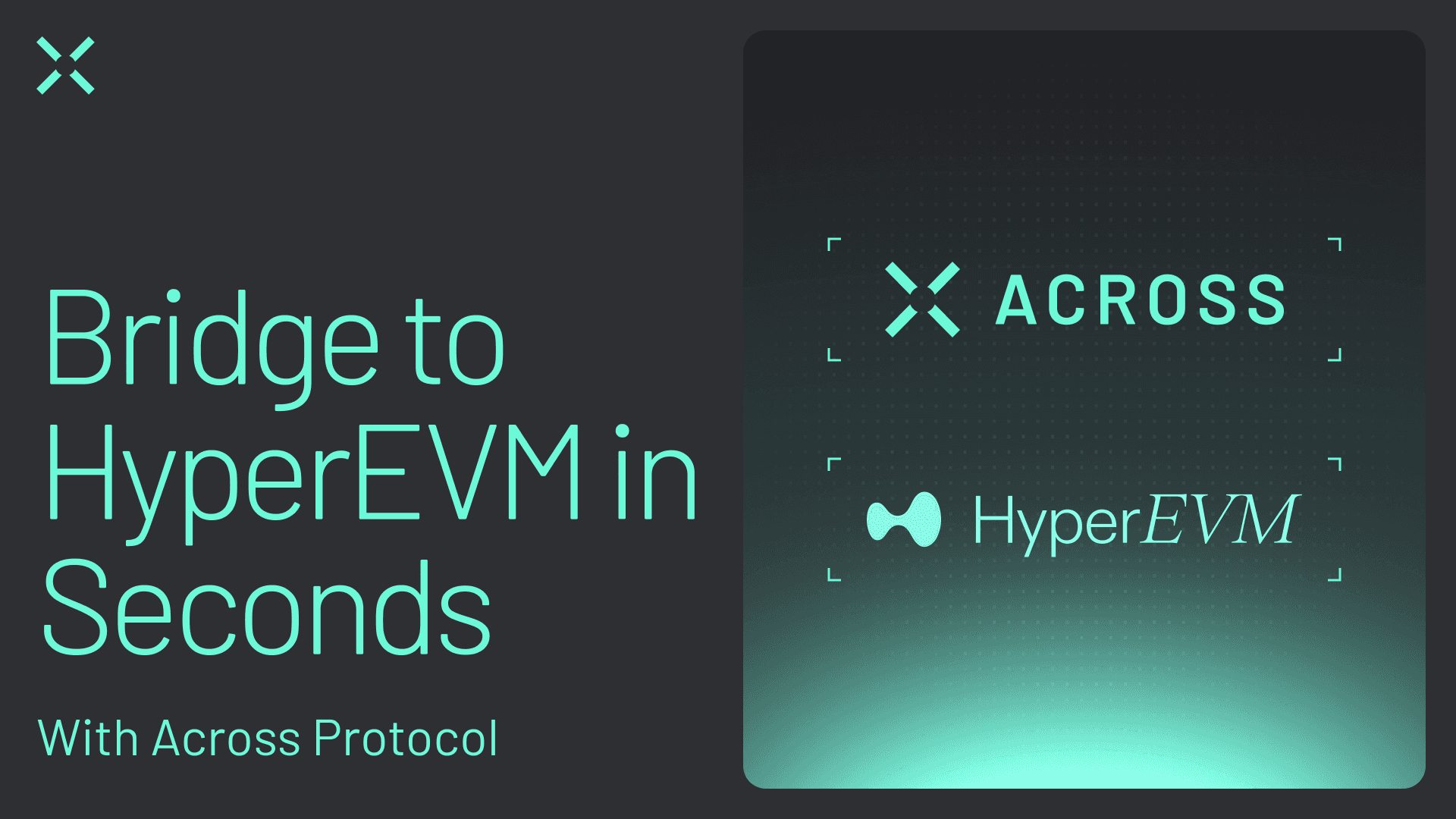Introduction: The Need for a Better HyperEVM Bridge
Hyperliquid has quickly become one of the fastest-growing crypto ecosystems, powered by its custom chain HyperCore. With the launch of HyperEVM, Hyperliquid now offers an EVM-compatible entry and exit point, opening its ecosystem to the broader Ethereum world.
But to truly unlock HyperEVM’s potential, users need a bridge that’s fast, cheap, and secure. That’s why Across has integrated HyperEVM directly into its crosschain stack. Now, you can bridge USDC and USDT to and from HyperEVM in just seconds, from any supported chain, including Ethereum, Solana, BNB Chain, Polygon, and more.
Across Protocol is powered by intents, secured by UMA, and proven in production with over $30B in volume and 4M users.
Here’s everything you need to know to get started.
What Is HyperEVM?
HyperEVM is an EVM-compatible blockchain that connects Hyperliquid’s custom HyperCore chain with the rest of the Ethereum ecosystem.
With the rapid rise of Hyperliquid, HyperEVM has experienced massive growth. At the time of writing this, HyperEVM has a total value locked (TVL) of $2.11 billion.
For developers, it feels just like Ethereum: the same Solidity contracts, Ethereum tooling, and familiar development environment. But under the hood, HyperEVM is optimized for high throughput, low-latency execution, and ultra-low gas fees, making it ideal for scaling DeFi apps and liquidity-intensive protocols.
In short: HyperEVM combines Ethereum compatibility with Hyperliquid’s speed, giving builders the best of both worlds.
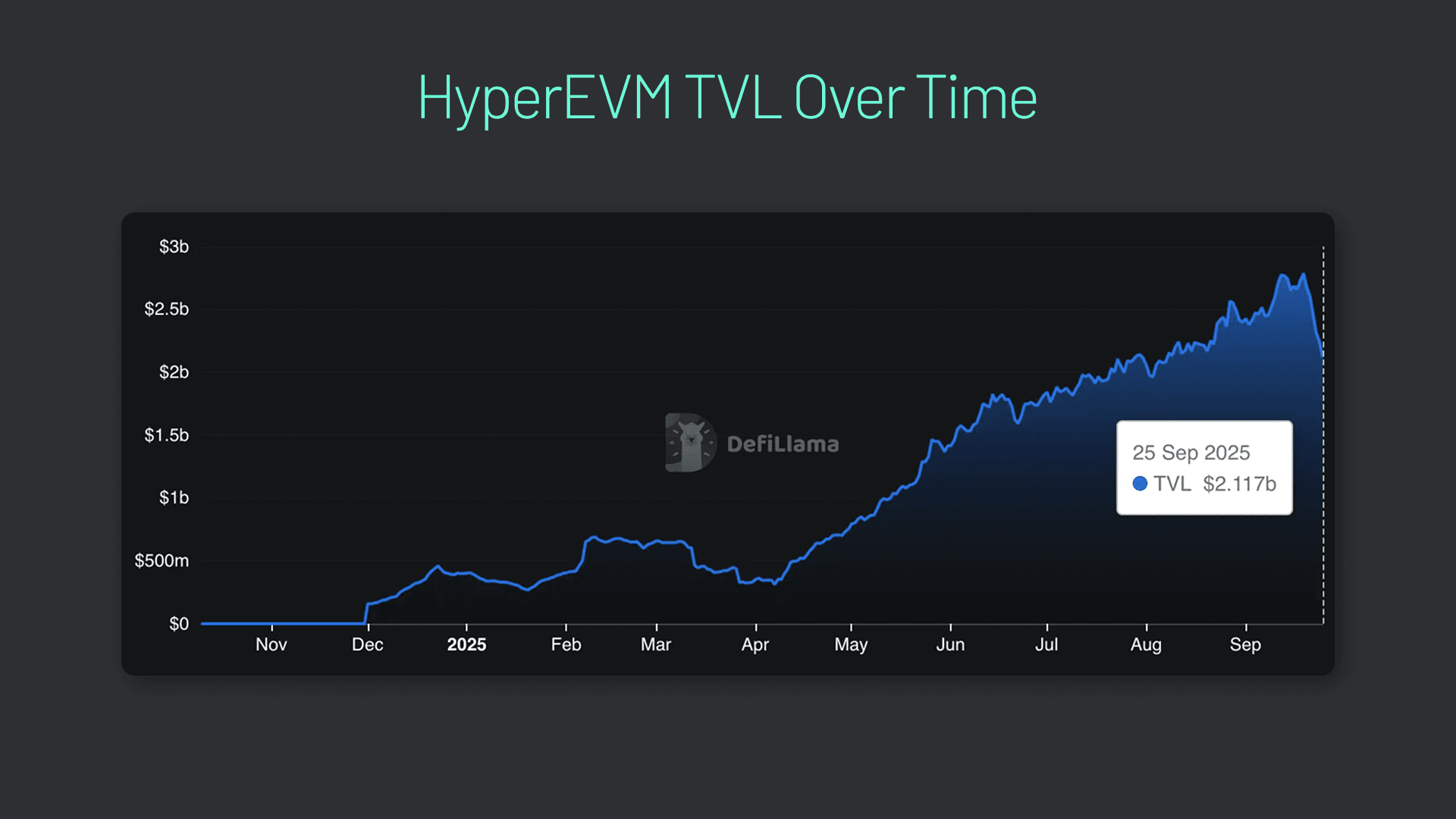
HyperEVM TVL has grown rapidly over the past year.
HyperEVM vs. Hyperliquid vs. HyperCore
The Hyperliquid ecosystem is a bit complex. To avoid confusion, here’s a quick breakdown of the three components of the ecosystem and how they fit together:
HyperEVM: The EVM-compatible chain that connects Hyperliquid to the broader Ethereum ecosystem, enabling developers and users to interact using familiar Ethereum tools.
Hyperliquid: The broader ecosystem and trading platform, known for its perpetuals exchange and growing DeFi products.
HyperCore: Hyperliquid’s custom high-performance chain that powers the exchange and core trading infrastructure. HyperEVM acts as the bridge between HyperCore and the rest of the EVM world.
This layered design allows Hyperliquid to maintain its custom performance-focused backend (HyperCore) while opening up to Ethereum-compatible development through HyperEVM.
Bridging Limitations: The Problem with Legacy Routes
Before HyperEVM, the only way into Hyperliquid was bridging through Arbitrum → HyperCore. That route worked but had clear drawbacks:
Limited token support: Mostly ETH and select stablecoins.
Clunky UX: Extra steps, long wait times, and poor wallet integration.
Higher transaction fees: Users often paid more in gas than they expected.
Fragmented liquidity: Harder for developers and protocols to attract users.
Other bridging models also fall short. Liquidity-pool based bridges fragment capital and increase smart contract risk. Wrapped-asset bridges introduce custodial trust assumptions and leave users holding synthetic tokens instead of native assets. Both approaches are slower, more expensive, and less secure compared to intent-based bridging.
These pain points made bridging to Hyperliquid costly and frustrating. HyperEVM fixes the base layer, but the real breakthrough comes when paired with a bridge like Across that eliminates delays and complexity.
Why Traders Use Across Protocol to Bridge to HyperEVM
Across Protocol is a unique crosschain platform. It is an intent-based bridging protocol purpose-built to move assets with maximum efficiency. Here’s why traders rely on Across to bridge to HyperEVM:
Speed: Transfer in seconds, not minutes or hours like with other bridges.
Low fees: optimized routing keeps costs lower than traditional liquidity-pool bridges.
Security first: No wrapped tokens, no user risk. All transfers are verified by UMA.
Battle-tested: $27.5B+ in volume, 17.3M+ transfers, and zero security exploits.
Chain support: Bridge from 21+ supported chains, including Ethereum, Solana, BSC, and more.
Token support: seamless bridging of USDC and USDT, the core stablecoins powering DeFi.
Across is trusted by leading projects across DeFi because it eliminates the risks of liquidity fragmentation and instead provides a unified crosschain liquidity layer. For HyperEVM users, that means every bridge feels instant, cheap, and reliable.
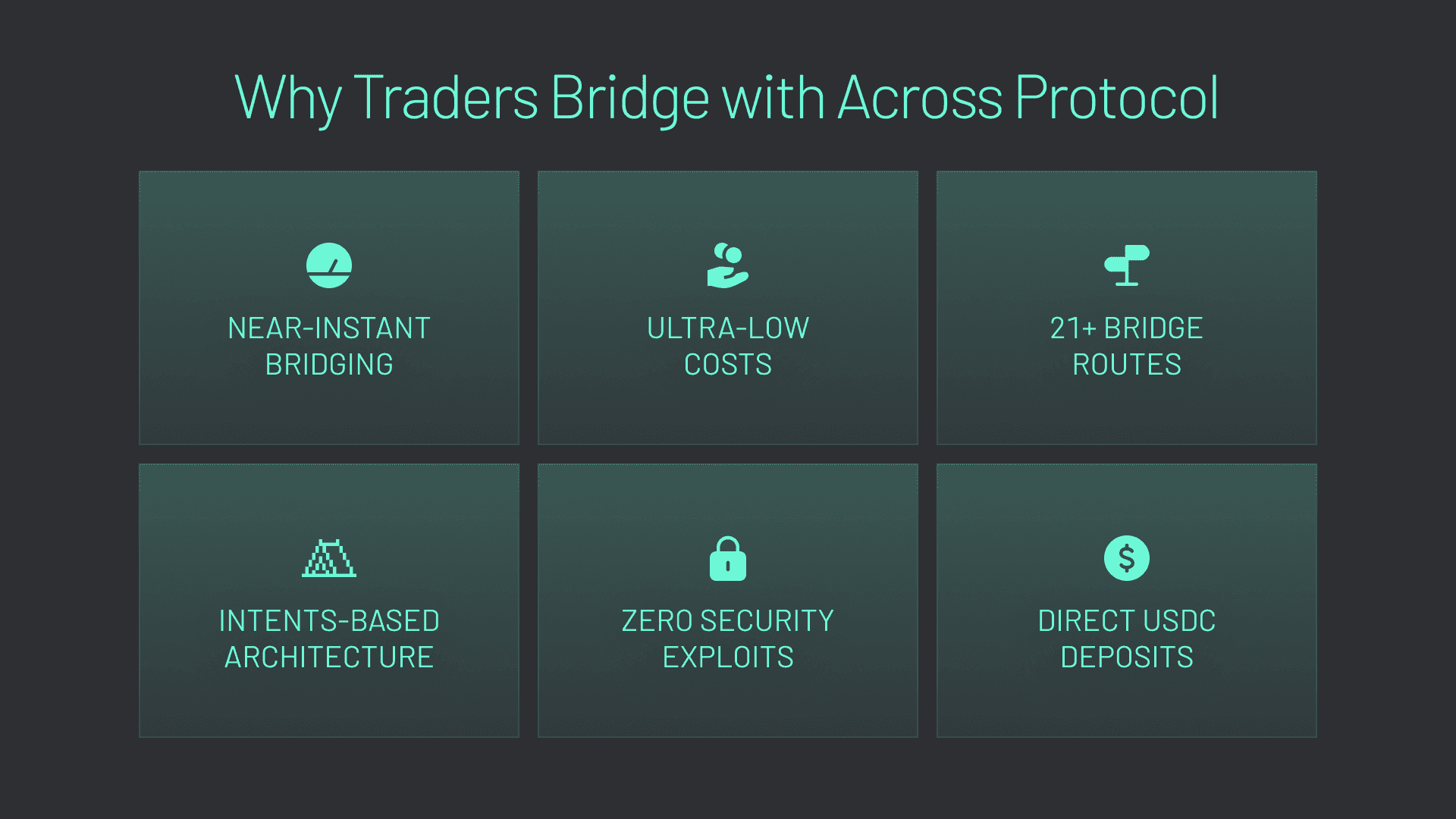
Traders bridge to HyperEVM with Across.
Step-by-Step: How to Bridge to HyperEVM with Across Protocol
Across Protocol powers fast, cheap, and secure USDC bridging directly to the Hyperliquid trading app. Here is the full process:
1. Go to the Across Bridge App
Navigate to app.across.to.
2. Connect Your Wallet
Use MetaMask or another wallet to complete your wallet connection.
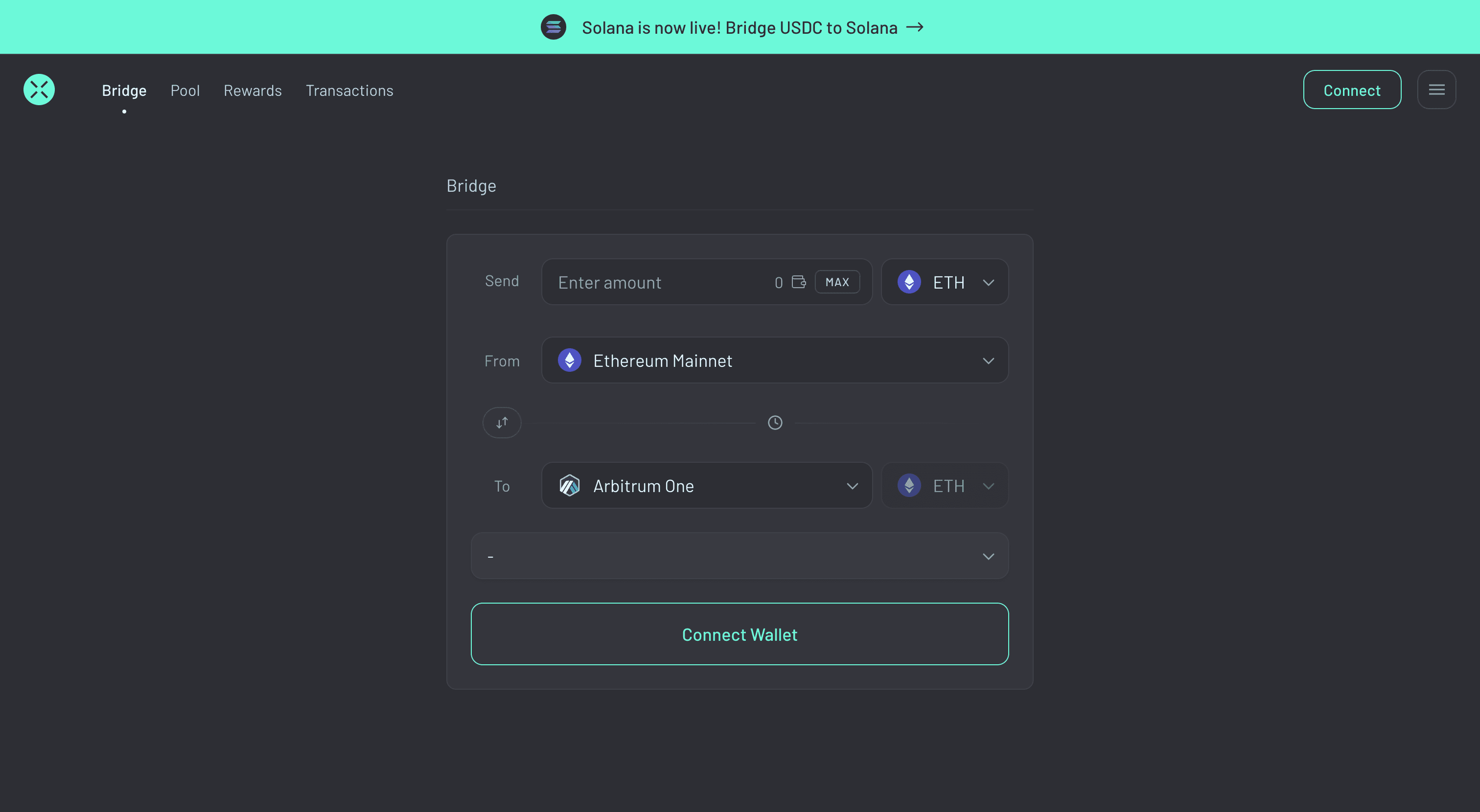
Navigate to the Across Bridge app and connect your wallet.
3. Choose a Stablecoin and Select Your Origin Chain
Pick USDC or USDT as your token and choose the chain you’re bridging from. In this example, we are bridging from Solana to HyperEVM.
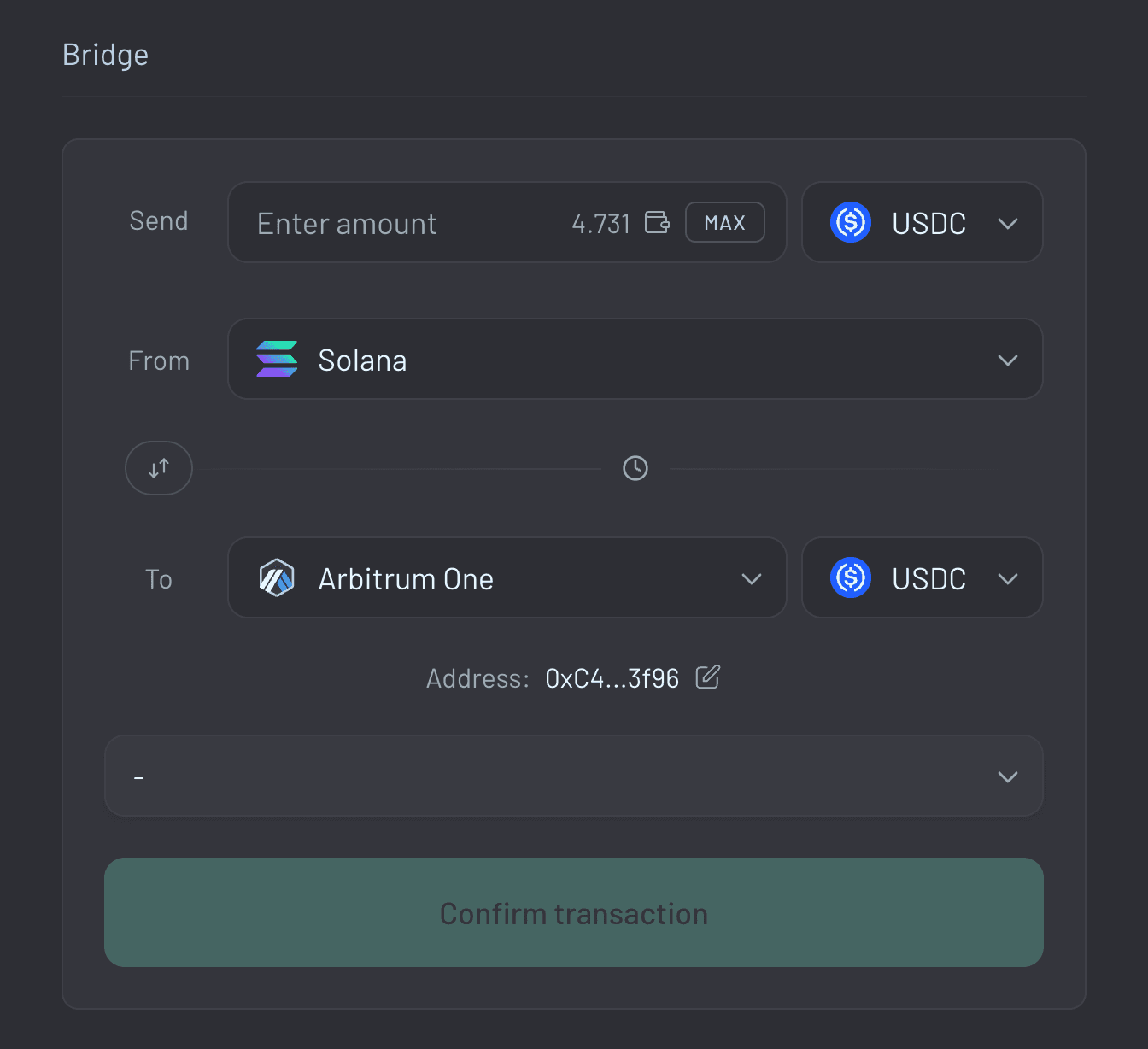
Select USDC or USDT and your origin chain.
4. Choose HyperEVM as the Destination Chain
Across relayers will automatically find the fastest and most cost-efficient route for you.
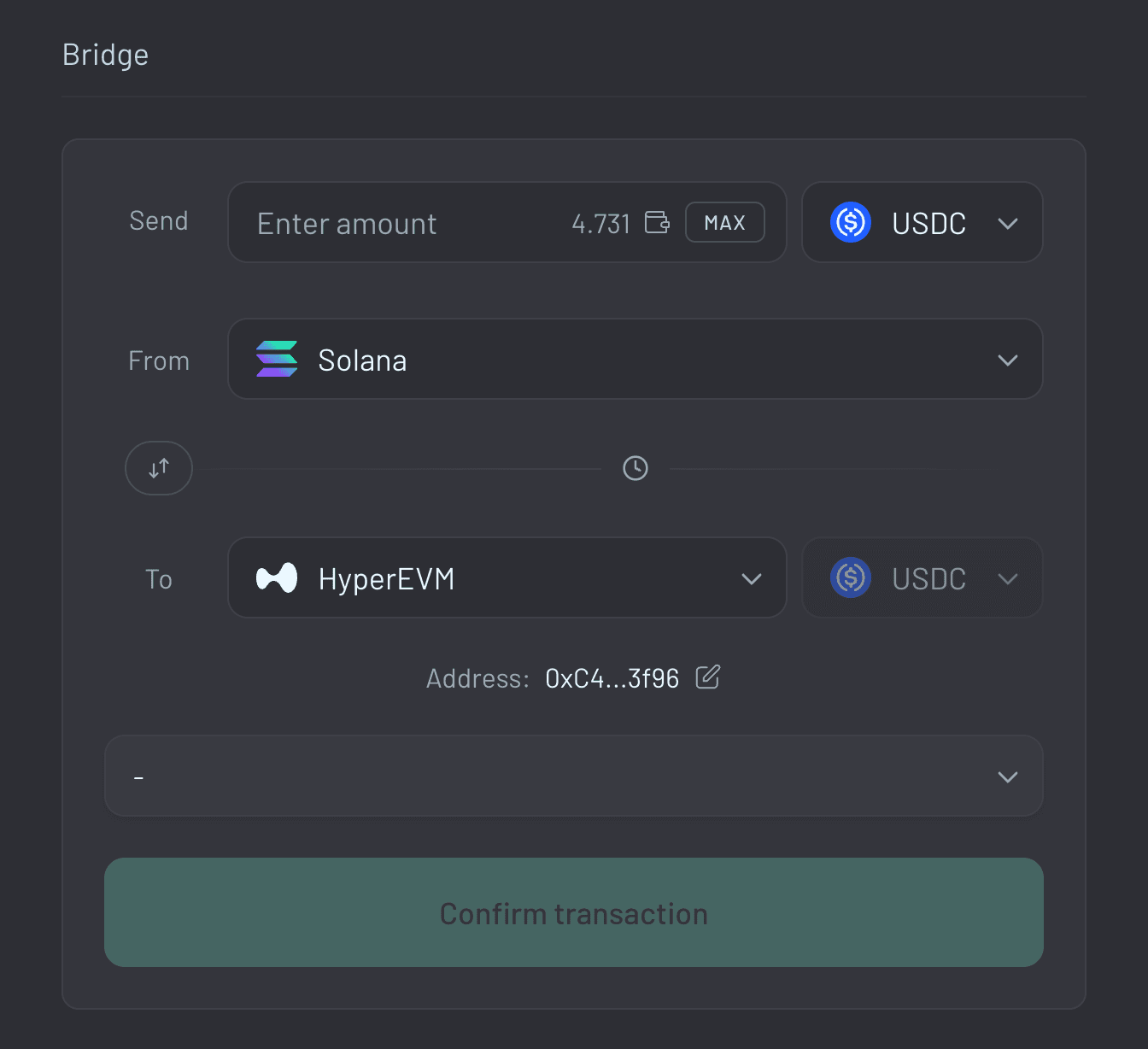
Choose HyperEVM as the destination chain.
5. Enter the Amount You Want to Bridge
Input the amount of USDC or USDT you want to bridge to HyperEVM.
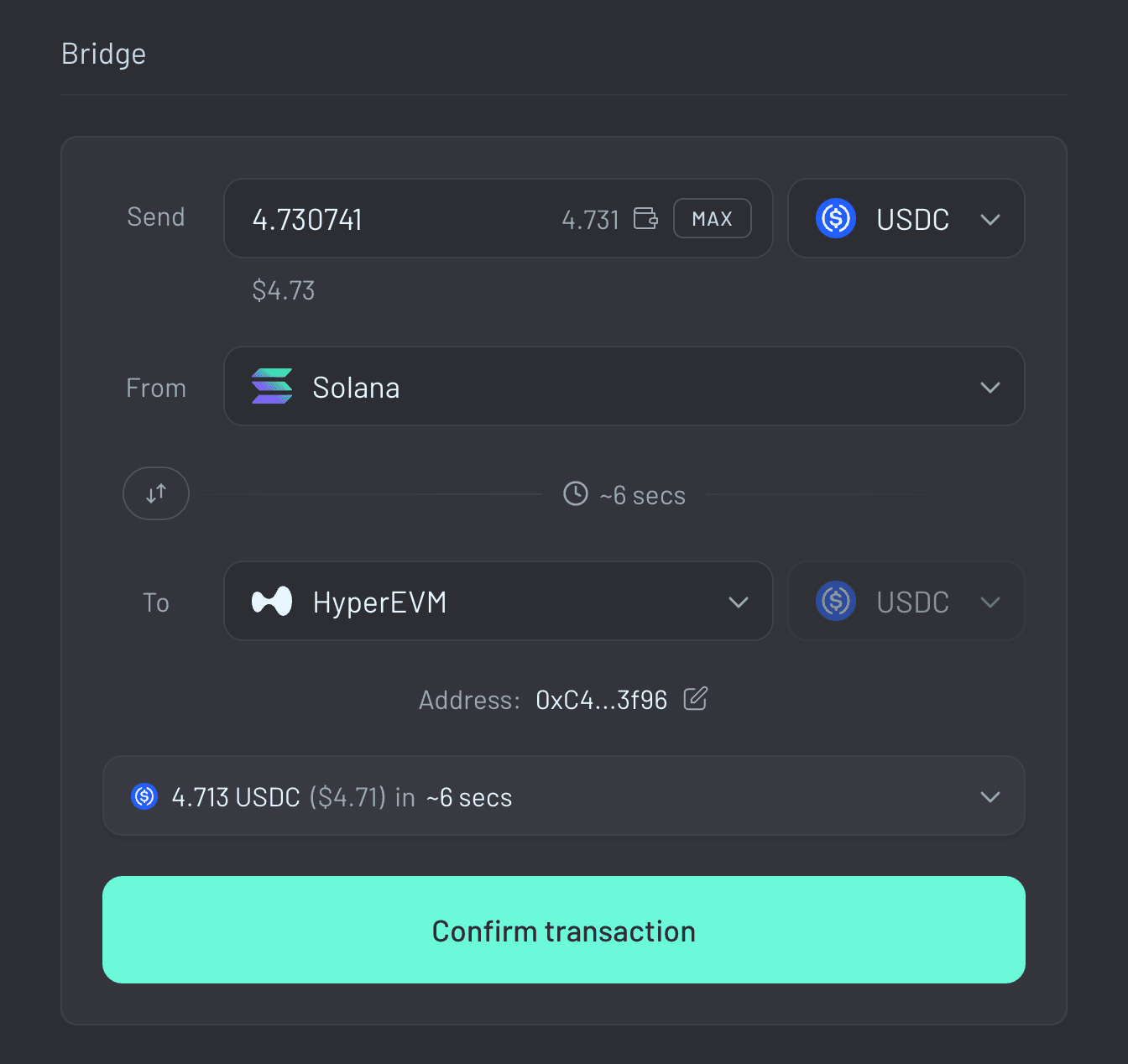
Enter the amount you want to bridge.
6. Review Fees & Timing
Check the gas costs, fees, and other estimated transaction details.
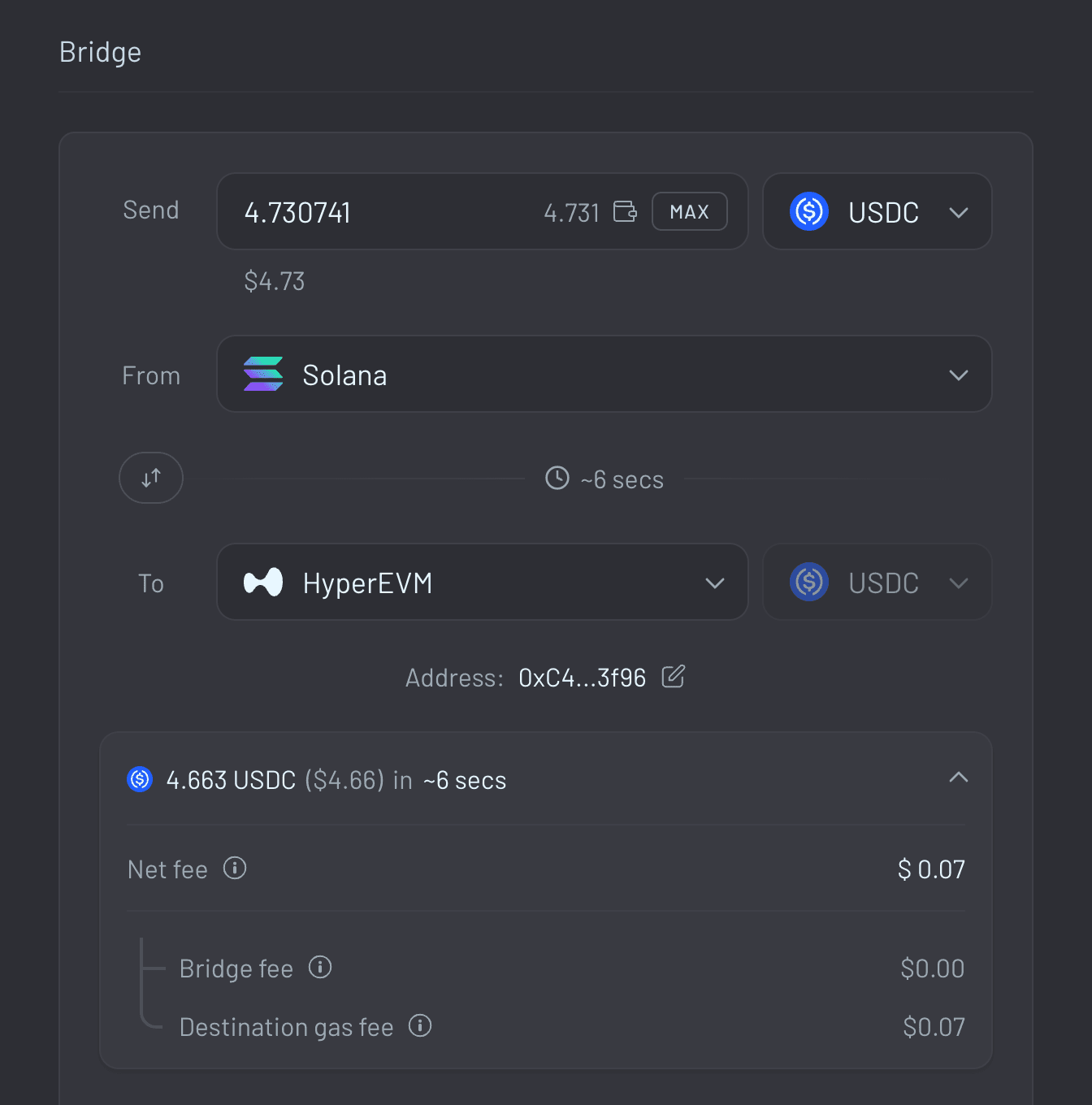
Review fees and timing details.
7. Confirm the Transaction
Click the “Confirm transaction” button, then sign and confirm the transaction in your wallet.
Note: If your wallet isn’t already connected to the right network, the button will say “Switch network and confirm transaction”. Simply click it and follow the flow.
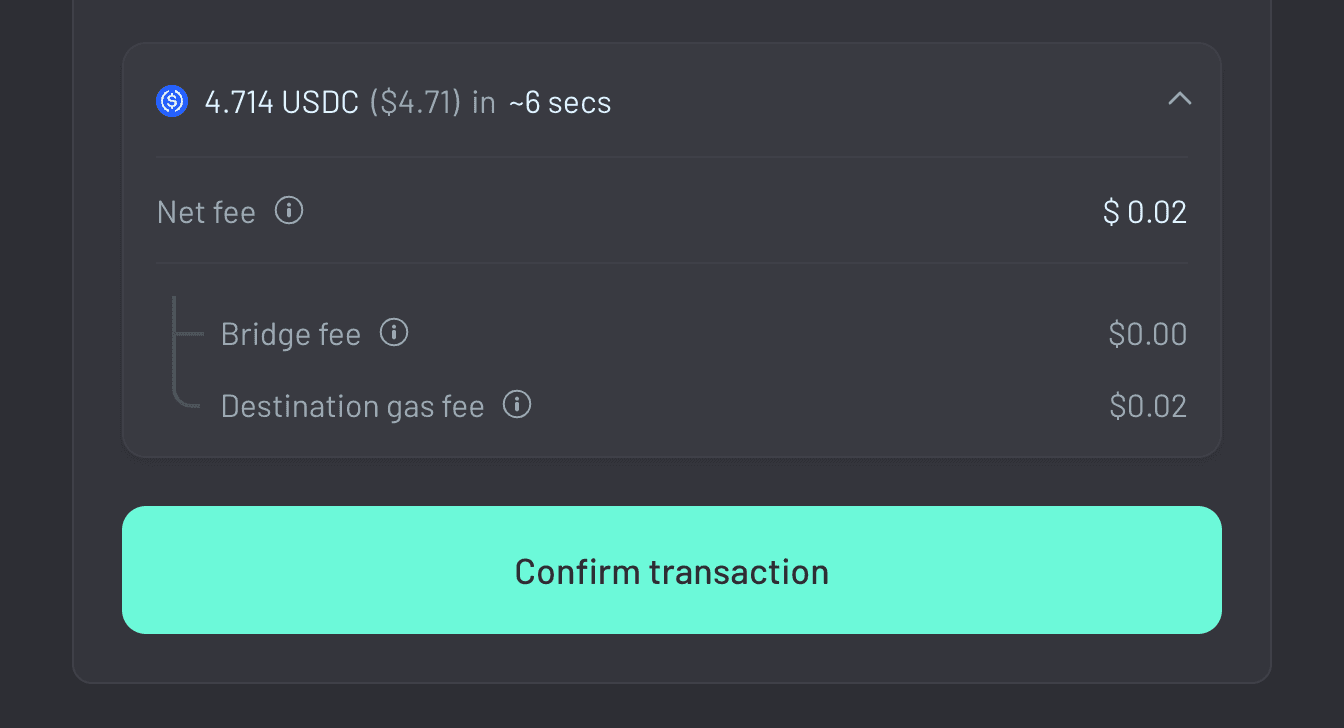
Confirm the transaction on the Across Bridge app and in your wallet.
8. Receive Your Stablecoins on Hypeliquid
Your USDC will arrive on HyperEVM in seconds.
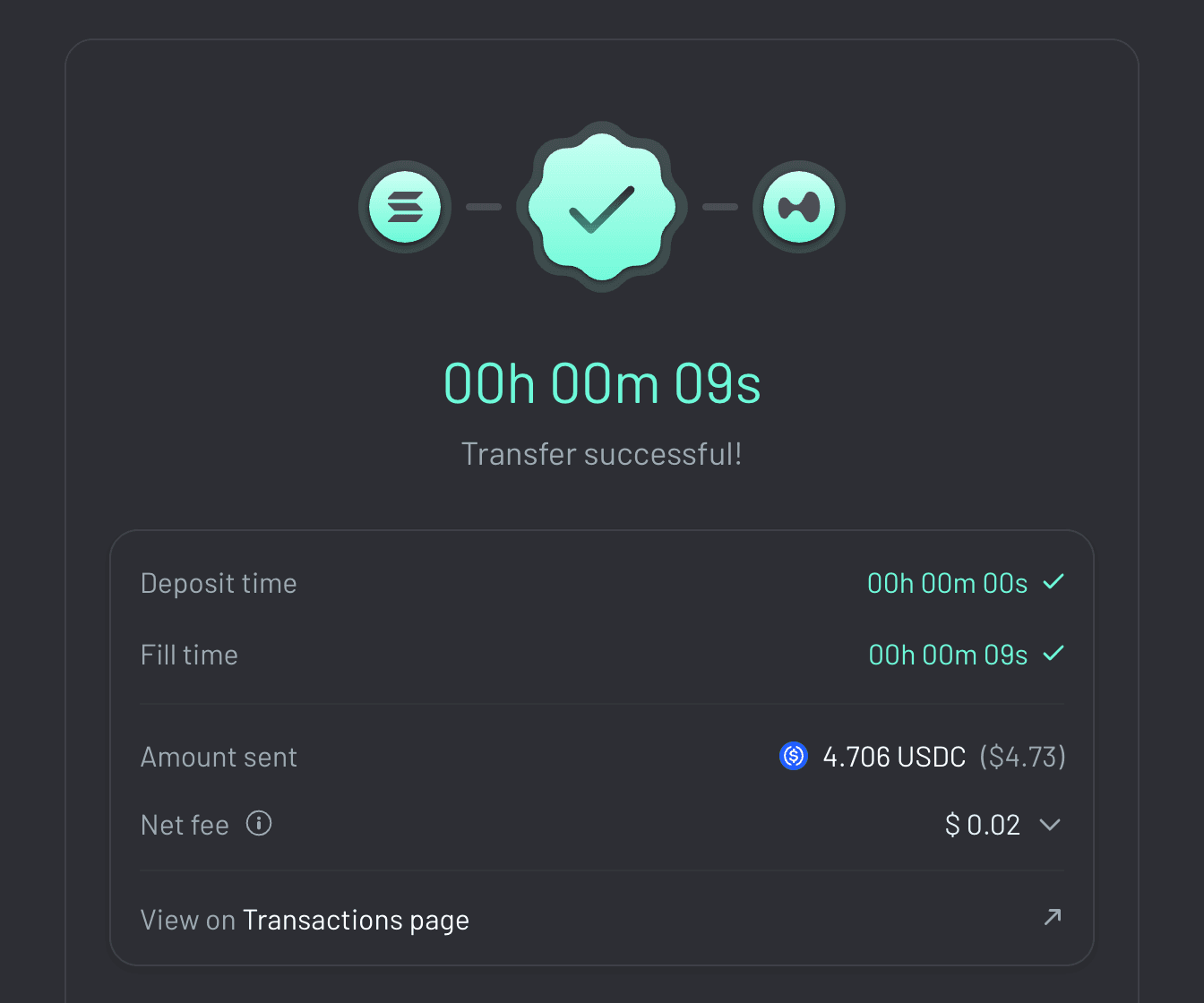
Receive your stablecoins on Hyperliquid.
This process takes only seconds, and bridging happens near-instantly. If you are a technical user, you can track your transfer on HyperEVMScan (the HyperEVM mainnet explorer).
Across Protocol: The Trader’s Gateway to HyperEVM
Across Protocol has become one of the most reliable and widely used bridges in crypto. Since going live, it has processed more than $30 billion in volume across chains, powering 18 million+ transfers for over 4 million unique users.
With support for 21+ blockchains and growing, Across connects Ethereum’s vibrant L2 ecosystem with major L1s, giving traders and builders unmatched reach. Transfers are incredibly fast, averaging 2 seconds on L2 → L2 routes, while fees remain consistently low (often under $1). Just as important, Across has maintained a spotless security record with zero exploits since launch.
The key advantage lies in its intent-based architecture. Instead of manually figuring out routes or liquidity, you simply state your goal (for example, bridging USDC from Base to HyperEVM). Relayers handle the complexity behind the scenes, and UMA ensures everything is correct. The outcome: your funds arrive on HyperEVM in seconds, securely and at minimal cost.
This blend of speed, affordability, and security is why Across is the preferred bridge for HyperEVM traders who want instant access to perpetual and spot markets.
Withdrawing or Bridging Out of HyperEVM
Moving funds back out of HyperEVM is just as important as getting in. Traders need speed for arbitrage opportunities, and protocols need liquidity to flow freely across chains. Across makes outbound bridging simple:
Navigate to the Across bridge app.
Connect your wallet.
Select HyperEVM as the source chain.
Choose USDC or USDT and enter the amount you want to withdraw.
Pick your preferred destination chain (Ethereum, Solana, BNB Chain, etc.).
Confirm the transfer.
Bridging out takes only seconds, though you’ll need a small amount of $HYPE, HyperEVM’s native gas token, to initiate the transaction. With Across, your capital never gets trapped. It flows freely in both directions.
The Role of Gas Tokens like $HYPE
HyperEVM uses $HYPE as its native gas token. Beyond paying for basic on-chain operations, $HYPE plays a crucial role in the ecosystem:
Transaction fees: required for swaps, transfers, and contract execution.
Ecosystem incentives: rewards liquidity providers and active participants.
Utility integration: expected to be embedded across DeFi apps, staking modules, and cross-chain routing.
For newcomers bridging in with Across Protocol, holding a small balance of $HYPE ensures smooth interaction with DeFi apps on HyperEVM. This design aligns with Ethereum’s ETH gas model while keeping fees ultra-low.
Key Features and Benefits of HyperEVM
HyperEVM is built to be more than just another L1. Its technical advantages make it a natural hub for liquidity and DeFi innovation:
EVM compatibility: Run existing Ethereum apps with no extra effort.
High throughput + low latency: Near-instant block confirmations.
Ultra-low gas fees: Transactions cost a fraction of what they do on Ethereum mainnet.
Token swap efficiency: HyperEVM is ideal for low-slippage swaps and liquidity provision.
When paired with Across Protocol, these strengths amplify. A high-speed chain connected to the fastest bridge creates a user experience where onboarding, trading, and liquidity flows happen seamlessly.
Start Bridging
HyperEVM is the gateway that connects Hyperliquid to the broader EVM world, and Across is the bridge to get there.
With near-instant transfers, support for USDC and USDT, and intents-based security, Across is the fastest and most secure way to bridge to HyperEVM.
FAQ: HyperEVM Bridge
How do I bridge to HyperEVM?
With Across Protocol, you can bridge to HyperEVM in seconds!
What assets can I bridge to HyperEVM with Across?
Currently, Across supports USDC and USDT. More tokens may be added as HyperEVM adoption grows.
How fast does bridging to HyperEVM take?
Transfers complete in only seconds thanks to Across’s optimized routing and liquidity system.
How much does it cost to bridge?
Across offers some of the lowest fees in the industry, often cheaper than pool-based bridges.
Do I need $HYPE for gas?
You do not need $HYPE to bridge to HyperEVM. However, once you have funds on HyperEVM, a small balance of $HYPE is required to pay on-chain fees when executing transactions or withdrawing from HyperEVM. You can acquire $HYPE through supported exchanges or within the HyperEVM ecosystem.
Can I bridge out of HyperEVM with Across?
Yes. Across fully supports inbound and outbound bridging, letting you move assets freely between HyperEVM and other chains.
Is the HyperEVM bridge secure?
Across uses an intent-based model secured by UMA’s optimistic oracle, avoiding the risks of liquidity-pool exploits and wrapped-token custodianship.
Which wallets can I use to connect to the HyperEVM bridge?
Popular wallets like MetaMask, Rabby, and Coinbase Wallet are supported for seamless cross-chain swaps.
Does Across support bridging from Ethereum, Solana, or BNB Chain to HyperEVM?
Yes. Across supports bridging from multiple chains, including Ethereum, Solana, BNB Chain, Polygon, Optimism, and more.
Can developers integrate the HyperEVM bridge into their apps?
Absolutely. Across offers a developer-friendly API and SDK that make it easy to embed HyperEVM bridging directly into dApps.
What is the HyperEVM bridge fee structure compared to other bridges?
Across fees are typically lower thanks to optimized routing and its unified liquidity model, which avoids fragmentation and slippage.
Join the Across community:

